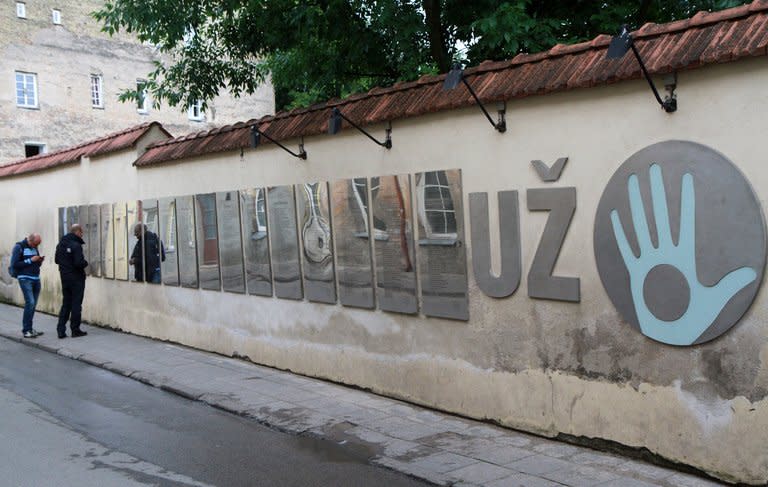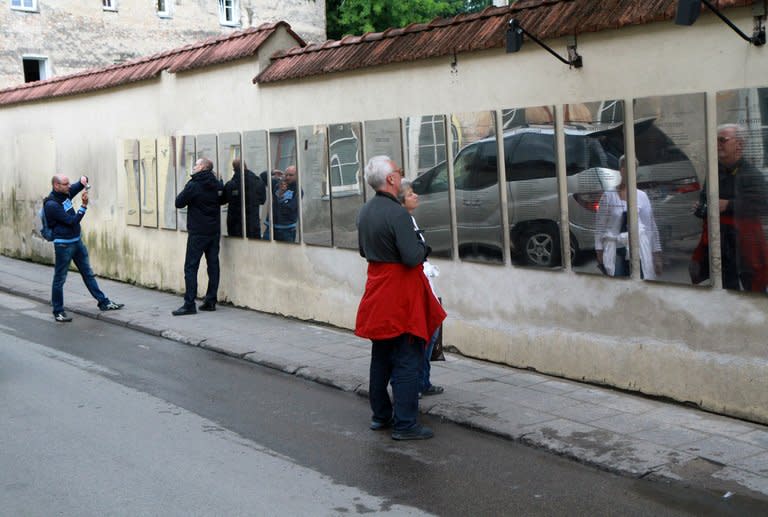The funky artists' republic in Lithuania's capital
The cozy artists' quarter of Uzupis in the Lithuanian capital has all the trappings of a republic with a twist: a light-hearted national holiday, a poetic president and a whimsical constitution in 18 languages. Set off from the rest of Vilnius by the shallow Vilnia river and linked by seven small bridges, the Republic of Uzupis -- which means "beyond the river" in Lithuanian -- fascinates locals and tourists alike. Artist studios cluster at the foot of the sloped district, peppered with vibrant graffiti and a mishmash of renovated brick buildings and tumbledown shacks. Its president, filmmaker Romas Lileikis, says people often wonder what his exact responsibilities are. "When I'm asked the question, I answer without hesitation: the president is in charge of the wind that flutters the flag," he has said. The sovereignty is clearly symbolic with the national anthem, flag, government and ambassadors all part of an aesthetic and intellectual exercise worthy of performance art. Vilnius's answer to Montmartre in Paris or Freetown Christiania in Copenhagen, the colourful, picturesque quarter was set up 17 years ago by a handful of artists as a Utopian dream. They wanted to carve out a nook of novelty in the city, built upon freedom of expression. "We had to express our values, meaning write them down in a constitution," Lileikis told AFP at a coffee shop along the river. Their tongue-in-cheek manifesto was unveiled on April 1, 2001 -- since feted annually on April Fools' Day as the national holiday -- with a first version in Lithuanian, then translated into 17 languages including French, Georgian, Gaelic and Yiddish. The constitution's 41 articles range from the earnest to the playful: "Everyone is responsible for their freedom"; "Everyone has the right to celebrate or not celebrate their birthday"; and "Everyone has the right to die, but this is not an obligation." The text ends with three injunctions: "Do not defeat," "Do not fight back," and "Do not surrender." A weekly farmers' market, the city's sole French bakery and a host of neighbourhood traditions make it one of the capital's most welcoming and lively areas. For St Patrick's Day, residents colour the river green. On Easter Monday, they enjoy a communal outdoor breakfast. "Here, everyone knows everyone else and says hi. People are constantly in a good mood," said Vejas, an Uzupis high school student always at the ready to help the republic. Wearing a fluorescent yellow vest marked "Uzupis customs", he stamped the passport of visiting Estonian President Toomas Hendrik Ilves last month with the republic's symbol: a wide-open hand. But this funky neighbourhood has not always been so friendly. "Twenty years ago, when I moved here, it was a district of bandits," Lileikis said. "On the main street someone had scrawled 'street of death'." Once seedy, the neighbourhood has sprung back to life with boutique shops popping up beside an artist's squat on the river banks near the Academy of Arts. The artist studios in disrepair have given way to new buildings unveiled in April, now home to 16 artists in residence as well as local art and souvenir shops. "New houses are being built, new residents are moving here and they're driving away the thugs and the thieves," street musician Nikodemas, a well-known face around Uzupis, told AFP. "As for the tourists, you can always avoid them by taking the side streets," he added, suitcase stowed as always on his bicycle rack. Artists aside, the neighbourhood is home to a relatively wealthy crowd of businessmen, lawyers, architects, journalists and the like. The Vilnius mayor is also a resident. But despite the renovation work and clean-up, "the ambiance hasn't become sterile," said Solveiga Gutaute, project coordinator for the artist's residence. "We're actually surprised," she added. "I've lived in other Vilnius neighbourhoods where the houses are like little boxes," built during the Soviet era, with no curves in sight, unlike the winding alleys in Uzupis. "There are still no angles here."



